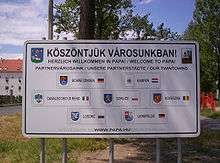Twin towns and sister cities

Twin towns or sister cities are a form of legal or social agreement between towns, cities, counties, oblasts, prefectures, provinces, regions, states, and even countries in geographically and politically distinct areas to promote cultural and commercial ties.[1] The modern concept of town twinning, conceived after the Second World War in 1947,[2] was intended to foster friendship and understanding between different cultures and between former foes as an act of peace and reconciliation,[3][4] and to encourage trade and tourism.[1] In recent times, town twinning has increasingly been used to form strategic international business links between member cities.[5][6]
Terminology
In the United Kingdom, the term "twin towns" is most commonly used; the term "sister cities" is generally used for agreements with towns and cities in the Americas.[1][7] In mainland Europe, the most commonly used terms are "twin towns", "partnership towns", "partner towns", and "friendship towns". The European Commission uses the term twinned towns and refers to the process as town twinning.[1][7] Spain uses the term "ciudades hermanadas" that means sister cities. Germany, Poland and the Czech Republic use Partnerstadt (De) / Miasto Partnerskie (Pl) / Partnerské město (Cz), which translate as "Partner Town or City". France uses Ville Jumelée (Twinned Town or City), and Italy has Gemellaggio (twinning) and Comune gemellato (twinned municipality).[8] In the Netherlands, the term is Stedenband (Cities-bond). In Greece, the word αδελφοποίηση (adelfopiisi—fraternisation) has been adopted. In Iceland, the terms vinabæir (friend towns) and vinaborgir (friend cities) are used. In the former Soviet Bloc, "twin towns" and "twin cities" are used,[9] along with города-побратимы (Ru) (sworn brother cities).[10][11]
The Americas, South Asia, and Australasia use the term "sister cities" or "twin cities". In China, the term is 友好城市 (yǒuhǎo chéngshì—"friendship city"). Sometimes, other government bodies enter into a twinning relationship, such as the agreement between the provinces of Hainan in China and Jeju-do in South Korea. The Douzelage is a town twinning association with one town from each of the member states of the European Union.[1][12]
City diplomacy
In recent years, the term "city diplomacy" has gained increased usage and acceptance, particularly as a strand of paradiplomacy and public diplomacy. It is formally used in the workings of the United Cities and Local Governments and the C40 Cities Climate Leadership Group and recognised by the USC Center on Public Diplomacy. A March 2014 debate in the British House of Lords acknowledged the evolution of town twinning into city diplomacy, particularly around trade and tourism, but also in culture and post-conflict reconciliation.[13] The importance of cities developing "their own foreign economic policies on trade, foreign investment, tourism and attracting foreign talent" has also been highlighted by the World Economic Forum.[14]
Europe
The earliest known town twinning in Europe was between Paderborn, Germany, and Le Mans, France, in 836.[3][15] Starting in 1905, Keighley in West Yorkshire, England, had a twinning arrangement with French communities Suresnes and Puteaux.[16][17] The first recorded modern twinning agreement was between Keighley and Poix-du-Nord in Nord, France, in 1920 following the end of the First World War.[6][17][18][19] This was initially referred to as an adoption of the French town; formal twinning charters were not exchanged until 1986.[20]
The practice was continued after the Second World War as a way to promote mutual understanding and cross-border projects of mutual benefit.[1][3][21][22][23] For example, Coventry twinned with Stalingrad and later with Dresden as an act of peace and reconciliation, all three cities having been heavily bombed during the war.[1][19][24][25][26] Similarly, in 1947, Bristol Corporation (later Bristol City Council) sent five 'leading citizens' on a goodwill mission to Hanover.[6][19] Reading in 1947 was the first British town to form links with a former "enemy" city - Dusseldorf. The link still exists (Reading-Dusseldorf Association: http://www.reading-dusseldorf.org.uk/). Since April 9, 1956 Rome and Paris have been exclusively and reciprocally twinned with each other, following the motto: "Only Paris is worthy of Rome; only Rome is worthy of Paris."[27][28]
Within Europe, town twinning is supported by the European Union.[1][3][6] The support scheme was established in 1989. In 2003 an annual budget of about €12 million was allocated to about 1,300 projects. The Council of European Municipalities and Regions also works closely with the Commission (DG Education and Culture) to promote modern, high quality twinning initiatives and exchanges that involve all sections of the community. It has launched a website dedicated to town twinning.[29] As of 1995, the European Union had more than 7,000 bilateral relationships involving almost 10,000 European municipalities, primarily French (2837 twinnings) and German (2485 twinnings).[23]
.jpg)
.jpg)
.jpg)
Public art has been used to celebrate twin town links, for instance in the form of seven mural paintings in the centre of the town of Sutton, Greater London. The five main paintings show a number of the main features of the London Borough of Sutton and its four twin towns, along with the heraldic shield of each above the other images. Each painting also features a plant as a visual representation of its town's environmental awareness.[30] In the case of Sutton this is in a separate smaller painting (above its main one) showing a beech tree, intended as a symbol of prosperity and from which Carshalton Beeches in the borough derives its name.[31]
Another example of the use of public art is the wall sculpture of the partner cities of Munich, Germany.
A recent study has concluded that geographical distance has very little, if any, influence upon communities' selections of a twin town or sister city.[32] Twinned towns are often chosen because of similarities between them; thus about 15 towns in Wales are twinned with towns in Brittany, and Oxford is with Bonn, Leiden, Grenoble and other university cities.[1] Many former West German cities are twinned with former East German cities; these twinning links were established before the fall of the Iron Curtain. Famous examples are the partnerships of Hanover and Leipzig, both of which have important trade fair grounds, or between Hamburg and Dresden. The first US-German town twinning was in 1947 between Worthington, Minnesota and Crailsheim.[1] St Petersburg in Russia holds the record for the largest number of partnership arrangements with other communities.[32] In June 2012, the Scottish village of Dull and the US town of Boring, Oregon, agreed to twin their municipalities to promote tourism in both places, playing on their names.[33][34][35]
Recently some towns have made novelty twinning arrangements with fictional or virtual locations. Wincanton, England is partnered with Ankh-Morpork from Terry Pratchett's Discworld books,[36] and the Scottish Isle of Skye has been 'virtually twinned' with Skylands, a location in the video game Skylanders: Swap Force.
Town twinning has increasingly been used to form strategic international business links. For example, in the 1990s, when the Nottingham City Council in the UK considered installing a tram network, it consulted experts from its twin city of Karlsruhe, which has one of the most extensive and efficient tram networks in Germany. With assistance from Karlsruhe's specialist engineers, Nottingham completed its second tram line in 2013.[5] More recently Bristol and New Orleans have announced their intention to form a 'tuning' partnership based on a shared musical heritage and culture offer, at the initiative of Bristol Mayor George Ferguson.[37] Annecy, France and Nerima, Tokyo have for several years shared a partnership based around their "co-existent animation industry".[38][39]
North America
The first city in North America to establish a sister-city relationship was Toledo, Ohio, which sistered with Toledo, Spain in 1931. Vancouver, British Columbia entered into an intercontinental twinning arrangement in 1944 with Odessa, Ukraine, which was part of the Soviet Union at the time. The initiative was based on Canada's aid to the allied port city during the Second World War. Liberal, Kansas was twinned with Olney, Buckinghamshire in 1950, and the cities have run a joint Pancake Day race ever since.[40][41] Tashkent, the capital city of Uzbekistan and also formerly part of the Soviet Union, was twinned with Seattle, Washington in 1973. Another first for sister cities or twin cities occurred in 1967 between Rochester, Minnesota and Knebworth, UK, both centres for primary medical research.
Sister City relationships begin for a variety of reasons. Generally, partner cities share similar demographics and size. They may arise from business connections, travel, similar industries, diaspora communities, or shared history. For example, the partnership between Portland, Oregon and Bologna, Italy arose from shared industries in biotechnology and education, appreciation for the arts, and a "similar attitude towards food;"[42] whereas Chicago's link with Warsaw, Poland began with Chicago's historic Polish community,[43] and the twinning of Indianapolis with Monza, Italy is due to both cities' long association with auto racing.
History
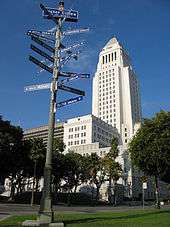
The US sister city program formally began in 1956 when President Dwight D. Eisenhower proposed a people-to-people, citizen diplomacy initiative. Originally a program of the National League of Cities, Sister Cities International (SCI) became a separate corporation in 1967 due to the growth and popularity of the US program.[44] SCI is now a nonprofit citizen diplomacy network that creates and strengthens partnerships between communities in the US and other countries, organises cultural exchanges, and provides support and funding. Under its administration, more than 2,000 cities, states and counties are partnered in 136 countries.[44][45]
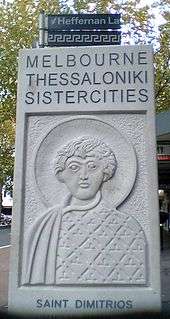
According to the SCI website, these exchanges include "musical performances, art exhibits, construction of peace parks or tea gardens, international cultural festivals, and teacher exchanges".[47]
Sister city cultural events include the annual National Cherry Blossom Festival in Washington, D.C., honouring Washington's sister city relationship with Tokyo City. Capitalizing on the growing world economy, many sister city members developed business agreements with their partners. For example, Vermont's Ben & Jerry's Ice Cream company opened a factory in Karelia, Russia, and offered the same profit-sharing plan to its Russian employees as its American employees enjoyed. While not a primary goal, business relationships are a natural by-product of sister city exchanges.
In 1995, the US House of Representatives passed legislation to eliminate the United States Information Agency (USIA) with vocal support from the US Conference of Mayors International Affairs Committee and Sister City members. The broadcasting functions of the USIA were maintained by the now independent Broadcasting Board of Governors (BBG); all other continuing functions became part of the organizational structure overseen by the purposefully established Under Secretary of State for Public Diplomacy and Public Affairs within the United States Department of State (DoS). SCI is a leading member of a consortium of non-profit NGOs that partner with the DoS Bureau of Educational and Cultural Affairs (ECA), which was created as part of this new organizational structure.
Through the grant funding, logistical support and other resources made available through the ECA, SCI and other organisations develop, administer and promote the United States Cultural Exchange Programs (CEPs). One such CEP is the Kennedy-Lugar Youth Exchange and Study Programs (Yes Programs), which sponsor students predominantly from the Middle East to study for a year in the US. On a 2004 exchange, Arab students from Gaza, Jordan, Kuwait, Lebanon, Syria, West Bank, Tunisia and Yemen lived in the US for a year with host families and attended a leadership summit in Boulder, Colorado. To further the Yes Program's goals, Sister Cities International developed the Youth and Education Network in 2004.
Asia
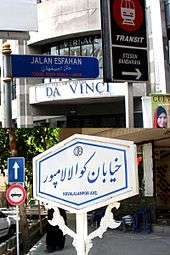
Sister city partnerships are supported in Japan by the Council of Local Authorities for International Relations, a joint agency of local governments established by the Japanese government in 1988 (similar to Sister Cities International, its counterpart in the US). More recently, Tokyo has begun to actively promote 'city diplomacy' with other global cities at the initiative of its governor Yoichi Masuzoe.[48] Daman, India is a twin town of the city of Coimbra, Portugal.[49]
Linguistic reasons
Relationships between communities can also arise because of shared names; they may be named after one community (as in the case of Córdoba), they may share names (as in the case of Santiago de Compostela), or their names may have a common etymology.
These similarities usually arise from sharing the same or related language, or from having been a colony or previously conquered.
Political purposes
Twinning towns and cities is sometimes done for political purposes. The Hungarian city Gyöngyös was twinned with the Azerbaijani city of Shusha in 2013, signing the twinning agreement with representatives from the Azerbaijani government; Hungary recognises Shusha as part of Azerbaijan, even though since the end of the Karabakh War it has been controlled by the military forces of Armenia and the unrecognised Nagorno-Karabakh Republic (de jure part of Azerbaijan).[50] An attempt was made in 2003 by Preston city councillors in England to twin with the Palestinian town of Nablus in the name of solidarity.[51]
Recently, city partnership termination—not just creation—started to be used for political purposes. In 2013, Milan and Venice, formerly twinned with Saint Petersburg, suspended their links due to St Petersburg's ban on "promotion of homosexuality to minors".[52] Other cities considered similar steps,[53][54] namely Los Angeles and Melbourne, where the campaign is led by Carl Katter. The cities of Glendale, California and Higashiosaka, Japan came close to terminating their sister cities relationship in 2013/14 on account of an ongoing dispute over Glendale's support for the erection of a statue dedicated to Korean comfort women in a city park.[55] In 2014, Prague terminated its partnership with Saint Petersburg and Moscow because of the Russian military intervention in Ukraine. Moscow had been Prague's partner city since 1995.[56]
Gallery
-

Louisville's sister cities
-
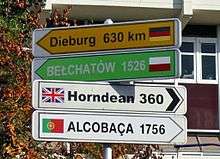
Aubergenville, France Villes jumelées
-
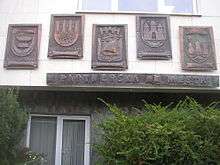
Insignia of twin towns on town hall in Kralupy nad Vltavou, Czech Republic.
-
Plovdiv, Bulgaria twin towns and sister cities directions
-

Ottobrunn, Germany Partnerschaftsschild Partner cities
-

Four twinning towns of Brzeg Dolny, Poland
-
Twin town signs of Kemi, Finland
-

Sign denoting twin towns of Neckarsulm and Baden-Württemberg, Germany
-

Zaventem, Belgium twin towns
-
Linköping, Sweden twin towns
-
.jpg)
Yalta, Crimea and Santa Barbara, California are sister cities
-
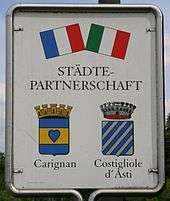
Coats of arms of Weinsberg's twin towns Carignan, France and Costigliole d'Asti, Italy
-

Twin towns sign in Osijek, Croatia
-
Bełchatów, Poland's twin towns
-
Holon, Israel, the Twin towns and Sister cities garden
-
The coats of arms of the twin towns of Dundee, UK, with their countries' flags
-

Worms, Germany partner cities sign
-

Welcome to Glastonbury, UK - Twin towns Lalibela, Ethiopia and Patmos, Greece
-

Town twinning commemoration, Godalming, UK
-
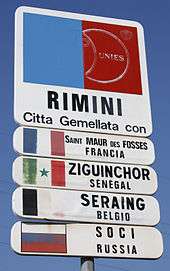
Rimini, Italy's twin towns and sister cities
-

'50 years of town twinning', German stamp from 1997
-

Kragujevac and Suresnes twinning agreement
-

Rochester NY Sister Cities Bridge and Chamber of Commerce
-

Chinatown, Philadelphia. The arch built in Qing Dynasty style, using tiles from Philadelphia's sister city, Tianjin, China
-

Partnership shield in Ilmenau, Germany
-

Twin towns and Sister cities garden in Holon
-
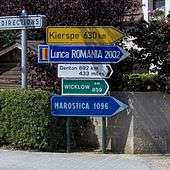
Montigny-le-Bretonneux, France twinnings
-

Melun, France twinnings
-

Zalaegerszeg, Hungary twinnings
-
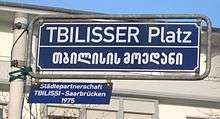
Tbilisi Platz in Saarbrücken, Germany
-
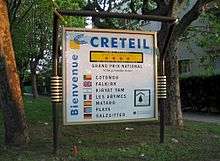
Créteil, France twinnings
- ^ "Sister Cities International (SCI)". Sister-cities.org. Retrieved 2013-04-21.
See also
- Council of Local Authorities for International Relations
- Cross-border town naming
- Douzelage
- Global City
- Lists of twin towns and sister cities
- List of twin towns and sister cities in Europe
- Most Ancient European Towns Network
- Paradiplomacy
- Partnership2Gether
- Sister Cities International
References
- 1 2 3 4 5 6 7 8 9 10 Clarke, N. "Town Twinning in Britain since 1945: A Summary of findings" (PDF). School of Geography, University of Southampton, final author version post peer reviewing (2011). Archived from the original (PDF) on 12 June 2009. Retrieved 2013-07-29. External link in
|work=(help) - ↑ "File:DPAG-1997-Staedtepartnerschaften.jpg". Retrieved 26 April 2016. External link in
|title=(help) - 1 2 3 4 "The Origins of Town Twinning" (PDF). Inverness: The City of Inverness Town Twinning Committee. 8 December 2008. Archived from the original (PDF) on 31 December 2010. Retrieved 2009-10-30.
- ↑ "What is town twinning?". L'Association des Communes Jumelées du Limousin. Retrieved 2013-09-05.
- 1 2 Brown, Tom (31 July 2013). "Twin towns: Do we still need them?". BBC East Midlands Today. BBC News. Retrieved 2013-08-07.
- 1 2 3 4 Handley, Susan. Judith Barton, eds. Take your partners – The local authority handbook on international partnerships. 2006 (10 ed.). Local Government International Bureau. Archived from the original on 17 July 2011. Retrieved 2013-08-13.
- 1 2 "Action 1 – Measure 1: Town Twinning". The Education, Audiovisual and Culture Executive Agency (EACEA). Retrieved 2013-08-26.
- ↑ Biblioteca Nazionale Centrale Firenze (BNCF) Thesaurus (Italian)
- ↑ "Mogilev: Twin Towns – Twin Cities". Mogilev city executive committee. Retrieved 2013-10-19.
- ↑ "Tbilisi, Vilnius become brother cities". Trend News Agency. Retrieved 2009-10-12.
- ↑ Self-Pierson, Rob (30 April 2012). "Is there a point to twin towns?". The Guardian. Retrieved 2013-07-14.
- ↑ "Douzelage.org: Home". www.douzelage.org. Retrieved 2009-10-21.
- ↑ "Lords Hansard text for 26 Mar 2014 (pt 0001)". Retrieved 26 April 2016.
- ↑ "Five key lessons for city competitiveness". World Economic Forum. Retrieved 26 April 2016.
- ↑ Lelièvre, Jean; Balavoine, Maurice (1994). Le Mans-Paderborn, 836–1994: dans l'Europe, une amitié séculaire, un sillage de lumière (in French). Le Mans: M. Balavoine. pp. 1–42. Retrieved 9 August 2013.
- ↑ Frank Crane (2008). War and World Government. BiblioBazaar, LLC. p. 200. ISBN 978-0-559-44381-7. Retrieved 2009-09-20.
- 1 2 "France Magazine – Twin Towns". www.francemag.com. Retrieved 2009-11-06.
- ↑ Handley, Susan (2006). Take your partners: The local authority handbook on international partnerships. London: Local Government International Bureau. p. 4. Retrieved 2009-09-20.
- 1 2 3 "Town twinning in the UK and Germany". East Street Arts. Retrieved 2013-07-29.
- ↑ "Keighley celebrates twin town jubilee". Telegraph & Argus. Newsquest Media Group. 2002. Retrieved 2009-01-05.
- ↑ "Ghajnsielem.com – Twinning". www.ghajnsielem.com. Retrieved 2009-10-10.
- ↑ "Twin Towns". www.amazingdusseldorf.com. Retrieved 2009-10-29.
- 1 2 Furmankiewicz, Marek (21 March 2004). "Town-twinning as a factor generating international flows of goods and people." (PDF). Institute of Geography and Regional Development, University of Wrocław, Poland. Archived from the original (PDF) on 29 July 2013. Retrieved 2013-07-29.
- ↑ Griffin, Mary (2 August 2011). "Coventry's twin towns". Coventry Telegraph. Archived from the original on 6 August 2013. Retrieved 2013-08-06.
- ↑ "Coventry—Twin towns and cities". Coventry City Council. Archived from the original on 14 April 2013. Retrieved 2013-08-06.
- ↑ "Disney seeks UK twin". www.ukprwire.com. Retrieved 2009-10-30.
- ↑ "Twinning with Rome". Retrieved 27 May 2010.
- ↑ "Les pactes d'amitié et de coopération". Mairie de Paris. Retrieved 14 October 2007.
- ↑ "Twinnings". Twinning.org. Retrieved 2009-06-16.
- ↑ "Murals for Sutton twin towns to get new lease of life". Sutton Guardian. 12 June 2011. Retrieved 10 September 2014. "Murals for Sutton twin towns to get new lease of life". London News. 12 June 2011. Retrieved 10 September 2014.
- ↑ "Revealing Sutton's twinning heritage 06.06.11: A set of murals celebrating Sutton's links with its continental twin towns is to be given a new lease of life." (Press release). London Borough of Sutton press office. 6 June 2011. Retrieved 10 September 2014.
- 1 2 Kaltenbrunner, Andreas; Aragon, Pablo; Laniado, David; Volkovich, Yana (16 February 2013). "Not all paths lead to Rome: Analysing the network of sister cities". arXiv:1301.6900
 [cs.SI].
[cs.SI]. - ↑ LeVeille, David. "A Tale of Dull and Boring Sister Cities". The World.org. Retrieved 2013-07-15.
- ↑ "Boring in Oregon votes to pair with Dull in Perthshire". BBC News. Retrieved 26 April 2016.
- ↑ Gambino, Lauren. "Dull and Boring? Sounds exciting". KVAL. Retrieved 22 February 2013.
- ↑ unknown (6 December 2002). "Pratchett city twins with real town". British Broadcasting Corporation. Retrieved 5 September 2013.
- ↑ unknown (27 February 2014). "How Bristol could become the New Orleans of the UK". Bristol Post. Retrieved 17 August 2014.
- ↑ 'Stimulation Project for the Coexistent Animation Industry Cluster in Nerima', Nerima City, January 2009
- ↑ 'Using pop culture to assert distinctiveness of place', Japan Local Government Centre, London, March 2011
- ↑ "Liberal wins 60th Int'l Pancake race". United Press International (UPI). Retrieved 30 April 2011.
- ↑ "Pancake Race 2007". Retrieved 26 April 2016.
- ↑ "Mission". Portland Bologna Sister City Association. Retrieved 16 July 2012.
- ↑ Leroux, Charles (31 July 2001). "Chicago has assembled a sorority of sister cities". Chicago Tribune. Retrieved 16 July 2012.
- 1 2 Sister Cities International Fact Sheet Archived 24 March 2012 at the Wayback Machine.
- ↑ Sister Cities International Mission Archived 28 April 2012 at the Wayback Machine.
- ↑ "Greek twinnings" (PDF). Central Union of Municipalities & Communities of Greece. Retrieved 2013-08-25.
- ↑ "Cultural Exchange". Sister Cities International. Archived from the original on 20 June 2012. Retrieved 16 July 2012.
- ↑ Alexander Martin. "Tokyo Governor Seeks Better Ties With Seoul". WSJ. Retrieved 26 April 2016.
- ↑ "Damão, Índia". coimbra.pt (in Portuguese). Coimbra, Portugual: Câmara Municipal de Coimbra. 2014. Retrieved 2014-11-17.
- ↑ "APA – Gyöngyös city of Hungary fraternize with Azerbaijan's occupied town of Shusha – PHOTOSESSION". Retrieved 26 April 2016.
- ↑ "BBC NEWS – UK – England – Lancashire – Nablus twinning bid rejected". Retrieved 26 April 2016.
- ↑ "Milan severs twin city ties with St Petersburg over 'homosexual propaganda' ban". The Telegraph. 2012-11-29. Retrieved 2012-11-30.
- ↑ Bajko, Matthew S. (15 August 2013). "Political Notebook: Cities asked to suspend ties with Russian counterparts". The Bay Area Reporter. Retrieved 2013-08-27.
- ↑ Kordunsky, Anna (14 August 2013). "Russia Not Only Country With Anti-Gay Laws". National Geographic. Retrieved 2013-08-27.
- ↑ "Japan city mayor lodges protest over "comfort women" memorial cost". GlobalPost. Retrieved 26 April 2016.
- ↑ "Prague suspends partnership with Russian cities". Prague Post. 2 September 2014. Archived from the original on 12 September 2014. Retrieved 2014-09-12.
External links
| Wikimedia Commons has media related to Town twinning. |
- European congress on citizenship and twinning
- Germany and the town twinning movement
- Town twinning in Europe's municipalities, towns and regions
- Twinning in Europe
- UK Town Twinning Portal
- "Twinnings for Tomorrow's World – A Practical Handbook" (PDF). Brussels: CEMR Council of European Municipalities and Regions. Archived from the original (PDF) on 13 May 2008. Retrieved 11 January 2010.
.jpg)


.jpg)

